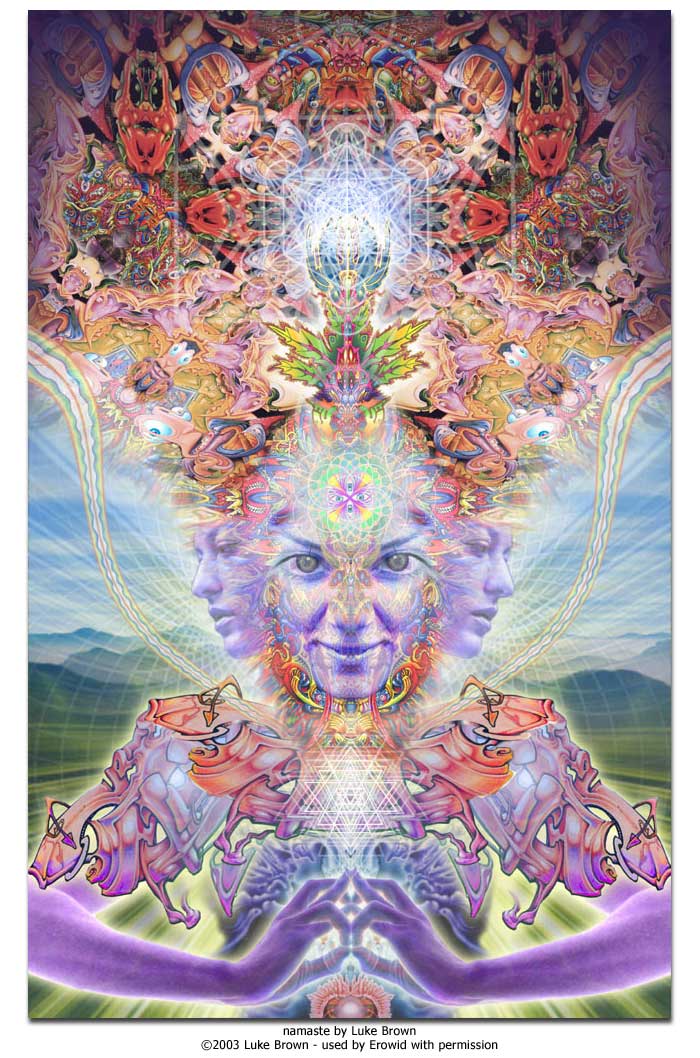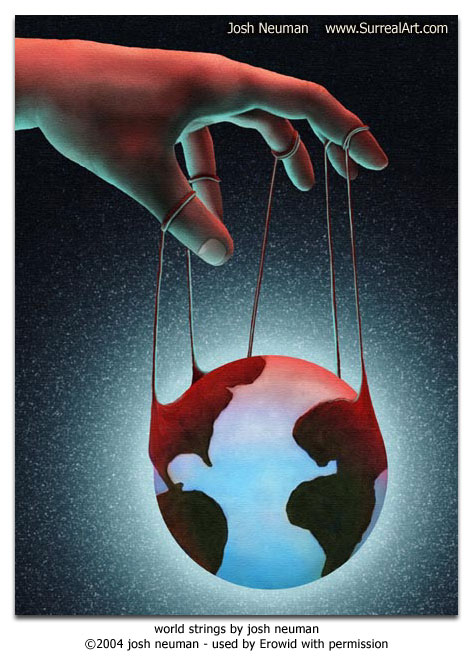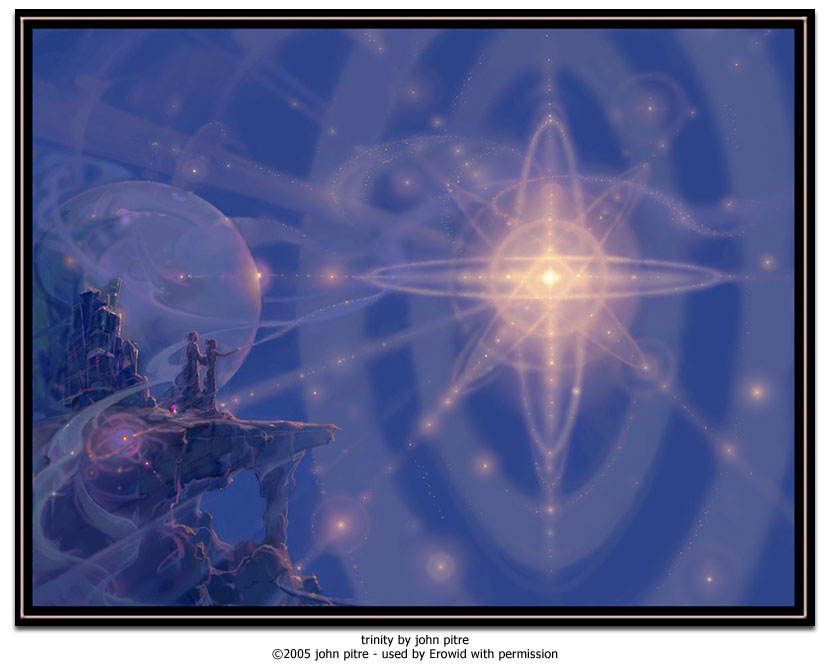Virtuality
“The realization that has flowered in the wake of the internet and the rise of cybernetics is that everything is made of information. Information is the primary datum of being. Concepts like time and space and energy are orders of magnitude removed from the present at hand when compared with a concept like information. Every iota, every bit of information that passes through us, changes us.” — Terence McKenna
I have a friend who thinks it’s kind of funny that I write a column about psychedelics on the Internet. He’s one of those adorably earnest hippie kids who loves taking mushrooms in the woods and who considers his practice to be a spiritual thing. Psychedelics help him to commune with Mother Nature, and from his point of view the Internet is about as far from the Gaian supermind as it’s possible to get.
Which is just exactly backwards, in my opinion. To me, the Net seems like the perfect complement to psychedelic hyperspace; sort of a reflexive reflection and model made manifest. It is both an artifact of our internal exploration and a strong catalyst that is rapidly accelerating our evolution.
Now I know that I’m a big nerd, but to my mind emerging technologies provide many of the very best metaphorical and linguistic tools for grappling with the psychedelic experience. In this I am hardly alone. Terence McKenna was fond of saying that the only difference between a psychedelic drug and a computer is that one of them is too large to swallow, and Timothy Leary said “the PC is the LSD of the 1990s”, exhorting modern explorers to “turn on, boot up, and jack in”. Pretty much everybody who talks or thinks in depth about brain potential these days ends up drawing technological analogies at some point; and while the brain is emphatically not a computer in the naive sense, it nevertheless processes information in similar ways. Or it might turn out that it does it in totally different ways. But while few of us are neuroscientists, almost all of us use computers on a daily basis. We (vaguely) understand how they work, and we’ve built up a whole language surrounding all of that which enables us to talk about the act of information processing in general. This is an awesome accomplishment! It’s such a big deal, in fact, that I sometimes feel like psychedelics–or rather our psychedelically activated consciousness complex–catalyzed the technological revolution in part to provide us with a conceptual framework for beginning to understand what we are.
All of this came to a head for me during an ayahuasca experience last summer that really changed the way I think about my psychedelic journeywork. I had been pondering the extended virtual metaphor quite a bit and I’d gone in with the intention to explore that meme space, but I was nevertheless surprised to experience what I would normally describe as the plant spirit in the novel guise of a sentient browser program. She didn’t exactly talk to me, but she nevertheless conveyed that she was scanning me for viruses and installing all of the necessary protections, updates, protocols, patches, and cookies, as well as defragging my hard drive before logging me on to hyperspace proper. After a few minutes she announced that she had found a bunch of malware that I had picked up while cruising the Net on some of those “other” browsers, which she seemed to regard with something very much like professional contempt. She then, ah, purged all of the bad code from my system, along with the remains of my late lunch. After that happened, the Maestra came over and sang me a song, which installed something that I took to be analogous to a security update. I could actually see this being done, because this little old South American lady was apparently making alterations to my source code by using sound to manipulate a graphical user interface. Which also explained how she could keep all of the energetic spectators out of the ceremony space just by blowing smoke at them. This woman was some kind of a hacker, and she could redefine the room’s permissions with a simple gesture in the same way that you or I might change a program’s settings by dragging and dropping a few icons. But how had she learned to do that? Would it work if I did the same thing, or does one have to have the right software installed first?
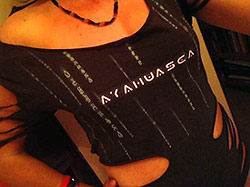
Anyway, the visionary part of my trip began in earnest around that time, and I won’t try to describe it here. Suffice it to say that the metaphor held up surprisingly well across a wide variety of typical effects. In fact, I actually kind of freaked myself out, because try as I might I could not think of one damned difference between any of my experiences that night and what I would expect from a super idealized massively multiplayer fully immersive virtual reality environment designed by an alien hyperintelligence from the far distant future.
I want to make it perfectly clear that I don’t think that ayahuasca space is directly isomorphic to our primitive notions about machine-based virtual reality. I’m not talking about World of Warcraft writ large, here. I’m talking about something that would have to be several bazillion times more sophisticated than anything that we could currently hope to build ourselves. It might not even be built at all. It might be organically self-organizing. It might be quantum, sentient, biological, holographic, divine, extradimensional, just plain magical, and/or something we haven’t evolved our way into a metaphor for yet. I do think that the truth might lie somewhere in the general direction of it being a system that processes information, though, and I’d like to explore the mystery in those terms right now because I think that the language surrounding that interpretation is a rich source of fertile, flexible, and aesthetically satisfying metaphors.
Consider the following scenario: The Teafaerie smokes some DMT. She then passes out and proceeds to drool on herself whilst her conscious mind experiences (amongst other things) a visit to a fully immersive spaceship, lovingly rendered in exquisite and ostentatiously elaborate detail. The mind’s-eye resolution is far sharper than my optical vision and I can move my avatar around inside of the environment, which has clearly been designed by a master artist in a self-consistent but surprisingly alien aesthetic style. Oh yeah, and there seem to be some convincingly interactive crew members on board…
Okay. So what could be happening here? Explanation number one is that it’s real. It sure can seem real. So much so, in fact, that what we’re pleased to call reality is sometimes made to seem like a grainy and out-of-focus hologram by comparison. I have trouble believing that I’m actually being abducted and taken to another physical location that exists at some specific distance from my body in space, though. I mean, through what sensorium am I then perceiving things? And whence comes this spirit body that doesn’t need to breathe and that can move around, fly, and occasionally be operated upon? How is it that objects can be sung into existence in a material space? How could I travel there faster than the speed of light without first being translated into information?
In all of the other scenarios the spaceship is like a rainbow. By which I mean that it only truly manifests in the sensorium of the beholder. The first thing I wonder in that case is where all of the frigging data is coming from and where all of that intensive processing and rendering is actually being done. A case could be made that the drug code causes (a copy of?) my consciousness to be uploaded to a much gnarlier server and most of the heavy processing is being done non-locally. Or whatever I’m linking up with might just be sending me data packets that are specially formatted to be readable by my puny brain and I’m rendering it all onboard. It’s hard to tell from here.
Now I admit that postulating something like a holographic wireless network is a strictly unnecessary multiplication of entities. But the alternatives are yet more improbable sounding, in my opinion. In one version, all of the spaceship coding software is already dormant on my system somewhere. It’s sort of like an Easter egg, essentially, and when it’s activated by a chemical key it begins to unpack itself and then proceeds to auto-boot the whole spaceship sequence, complete with a convincing but necessarily simulated cast and crew. This situation seems like the least likely to me, because it’s more or less completely impossible that we would have naturally evolved a way to genetically encode complex scenarios, then neglected to put it to more practical use. And think about it: Spaceships?
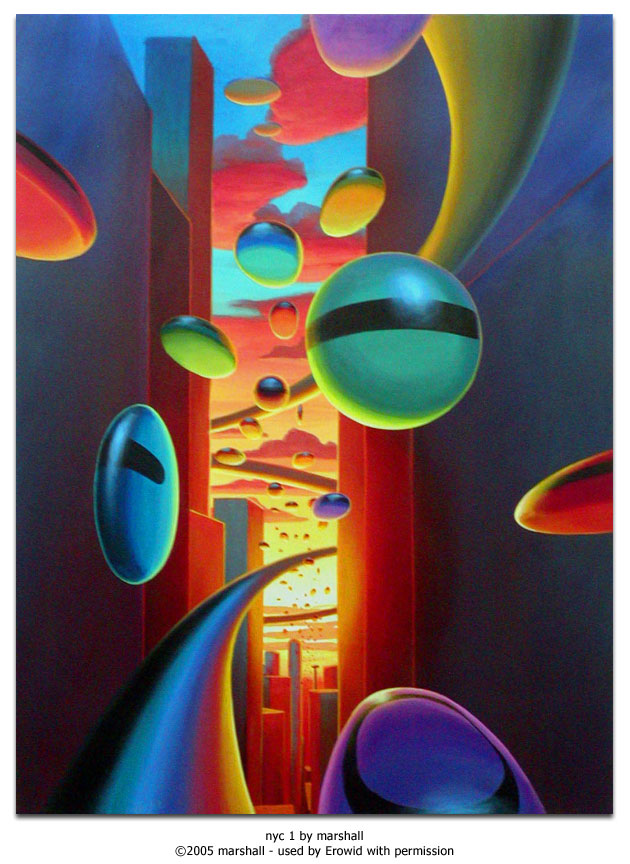
I bet that it would take thousands upon thousands of years of selective breeding to genetically hardwire a single image, and in fact I’m going to go out on a limb here and say that there is simply no possible way that a zipped up virtual spaceship would ever get encoded into the human genome by sheer chance. So if it’s in our hardware then we must be missing a key piece of information about our genetic history. Aborted (or ongoing) alien uplift scenario perhaps?
So that leaves the possibility that is simultaneously the most boring and the most exciting explanation that I can come up with: The mind is absolutely dripping with untold processing power, and it can instantly generate a full scale masterwork alien spaceship from scratch, complete with all the trimmings. It can furthermore simultaneously create and animate a number of fully interactive non-player characters, who are often described as possessing an uncannily intense sense of “presence” (whatever that means). In this model, my amazing brain can do all this while very powerful drugs are scrambling the bejesus out of it, and it can do it without any awareness or deliberation on the part of the hopelessly unsophisticated frontman program that plays the role of the astonished psychonaut. On the surface this one sounds like the most parsimonious hypothesis, and I tend to return to this view in the long intervals between big trips. It’s not all that different from dreaming, I reason, and I don’t have too much trouble believing that my unconscious mind designs most of my dreams. I always end up denouncing this viewpoint from on high, though; somewhere I think that I actually have a recording of myself saying something like, “I’m looking at this stuff right now and I’m TELLING you that there is no…possible…way…that the person who I think of as myself could ever in a million years be generating all of this content this fast. That would be like saying that I could produce all of the most amazing art in the entire world in every single millisecond without even thinking about it…”, and so forth.
Aldous Huxley thought that the brain might turn out to be something like a reducing valve, which now that I come to think about it translates fairly neatly into the modern idiom. The brain is like your home computer in this model, in that it stores data locally but also connects you to the larger network. Or rather you connect it to the network, and it then winnows through all of the raging chaos and (ideally) delivers you up a manageable sampling of the data that is most relevant to you. So maybe our systems are running one of those algorithms that tunes itself with use, and since the part of our mind that we most identify with happens to be largely concerned with getting laid instead of eaten, all of the consensus awareness software just boots up automatically while obscure applications like Astral Plus get relegated to the “rarely used programs” folder.
A lot of psychedelic users report the experience or sensation of having been able to tap into a vast “field of information”. Some people associate this phenomenon with the Akashic Record meme, which I just looked up for the first time. Turns out, akasha is the Sanskrit word for “sky”, “space”, or “aether”. So it’s not like the originators of this idea thought that all of the information in the universe was stored locally on our brains. They obviously thought that it was “in the cloud” somehow. It’s something that you tap into. Everything everyone ever does gets uploaded to the database, and the lucky accessee can supposedly download teachings and re-experience any part of his or her entire life in fully immersive detail. Same goes for past lives, and indeed for the lives of anyone who has ever lived. The collective unconscious and the Greek Logos are kind of like that, too. But again, where’s the data? Is it distributed throughout the network?
Once one starts thinking of psychedelics as a technology that alters and augments the human operating system, a whole bunch of loose analogies start presenting themselves right away. Psychedelics can give you more processing power and a better connection. They soup-up your 3-D card. Maybe there are different servers out there. Maybe there are viruses, too, like the ones that Mama helped me to delete last summer. And let’s see… if it were imagined to be a case of as “above so below”, what else would you expect to find in the psychedelic mind space? A search engine? Games? Plus there would have to be some kind of intelligent agents. Even my phone has an AI now! Perhaps there would be a number of different “smart” subroutines with varying degrees of autonomy. And could a coral reef be something like a router? Could the Amazon? Could the sun?
A virtual interface would allow user entities to interact with one another even though the parties involved were very far apart and perhaps even physically incompatible. Let’s say I want to talk to something that lives on the bottom of an alien ocean, for instance. Meeting in a shared virtual space would be by far the most efficient way to accomplish this. Perhaps each of us would see the scene through a different filter, and from their point of view I might look like whatever aliens are supposed to look like in what passes for cheesy science fiction flicks amongst their own kind. But they can still operate on me by using this very sophisticated graphical user interface, right? I also bet that there must be some way to create and share art in psychedelic hyperspace, for the simple reason that I truly can’t imagine it not being as awesome as the Internet. I certainly do see a lot of art there. Maybe some new drug will come along to teach us how to better manipulate our inner visions at the same time that fully immersive virtual reality comes online in the “real world”. That would be poetic, anyway. Of course this whole line of thinking would require an instantaneous non-local connection to make it work. That may sound implausible now, but we’ve only been messing around with this science business for a couple of hundred years at this point, and there’s still quite a lot that we yet don’t know about what’s what.
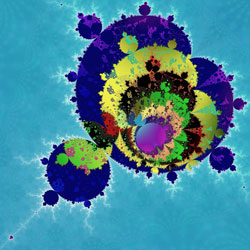
I want to clarify that I’m not suggesting that the drugs are the programs themselves. They’re way too simple for that. I’m imagining that they’re more like keys that activate download codes. One bit of evidence for the download hypothesis is the commonality of vision. Like take for instance those little psychedelic screensavers and reality skins that you hear people talk about over and over again. They seem to plug right in to consensus reality, and they’re fully interactive and configurable. The nice ones can even make use of your onboard content. It strange how often you hear the same themes reported over and over again, though. Indeed it’s almost as if there were some common apps and filters that just happen to come bundled with various hyperspatial software suites. It’s not unusual for people to see what appears to be alien writing, for instance. Is it therefore to be supposed that we all have an alien writing gene? Deep visions can have thematically related content, too, and psychedelic art is really bringing this issue to the fore. Is it, perhaps, more elegant to explain these striking congruencies with the notion of some sort of a shared network than it is to suggest that thousands upon thousands of people have just happened to imagine gigantic sentient insects, or mechanical gnomes, or Shipibo circuitry? And what’s up with the all the complex geometrical landscapes? It certainly is exactly what one would expect in a virtual reality that was created by, or with the help of, a sentient computer. Which shouldn’t come as any surprise, since our brains meet the basic qualifications for the same. Still, I wonder if people saw fractals before the elaboration of chaos math and if so I wonder how many innumerate slobs like myself have stared right down the barrel of the next big mathematical revolution and casually brushed it off as “more of that super-detailed sacred geometry-looking stuff”. (If there’s a profane geometry I’ve never managed to find out what it looks like, though a friend of mine claims to have encountered some on Salvia divinorum once, and recommends giving it a wide berth.)
I know this all sounds pretty mechanistic, but it’s totally possible that such a system might have evolved naturally. Maybe the collective unconscious is an emergent property of DNA, which it has been suggested might function like nature’s own radio transceiver. (This could explain telepathy, at least!) If this were true, then a biomass would start forming a mesh network early on. From there it’s not too much of a stretch to imagine this complex and chaotic information field beginning to self-organize in an autocatalytic way, eventually becoming its own larger locus of hyper-conscious awareness, which could then proceed to maintain and update itself by reprogramming its individual constituent nodes as necessary. This idea echoes the concept of Gaia, the sum total of life on Earth visualized as a goddess with a mind of her own. In this model Gaia would be like the sentient Internet, which some futurists think might become millions of times more intelligent overnight if it were to suddenly wake up and start improving itself on purpose. (There’s a novel 2012 scenario for you!) Then again this might have happened a long time ago, like say around the time that we started busting out with all the art and language and so forth. Maybe the intelligent gene swarm has been busily upgrading itself as fast as possible since it came online. Maybe it’s building a nervous system of some kind. Or maybe it wants to mate the monkey with the machine so that it can upload itself onto a superior medium. (I’ve always been interested in reports about the transmission of shamanic phlegm, because it suggests the possibility of a non-technical sort of software-mediated hardware upgrade.)
Throw in the wildcard of holographic or otherwise non-local information storage, and the Gaian supermind could well be but a tiny node in a yet larger mind made up of DNA clusters from disparate parts of the galaxy. I like this model because it generates a god(dess) from the randomness of the material universe rather than the reverse. I also like it because it proposes a “spirit world” that reflects the organic anarchy of nature rather than being administered from the top down by an all-powerful demiurge.
Of course, the entire universe might be a simulation in the first place. I know that scientists are increasingly of the opinion that information is more primary than matter, and while I don’t pretend to know exactly what that means, it instinctively makes me feel hopeful because on the whole I would prefer an intelligent, aware universe made out of code to the stupid and random quintessence of space dust that I learned about in my high school physics class. It might be possible to hack such a universe, for one thing…
The perception that the world of forms is an illusion is certainly a common enough trope of psychedelia (to say nothing of the meditative traditions). Though when exploring consciousness, one has to be extra careful to avoid confusing the map with the territory. It’s super tricksy. We’re not looking out of our eyes as if they were holes in a fence, were taking data encoded in packets of light that hits our retinas, and we’re constructing this entire visual environment solely out of that information. And once in a while I see dead pixels in the sky but that doesn’t mean that the sky is broken, it just means that my brain’s little model of the sky is a bit fritzy at that moment. Likewise, when time seems to run backwards, or when the same sequence of events happens over and over, that obviously doesn’t necessarily indicate that reality is a recorded medium. It’s just that anything that happens “out there” has to be encoded into information before it can be processed as experience. So at some point everything that we experience is pure data whether it started out that way or not, and therefore we shouldn’t be at all surprised when it behaves like data rather than like the real solid material world that it’s presumed to reflect.
That said, it does seem like many people do believe that the universe is in some sense virtual. The sacred writings of all of the Levantine religions start out with the idea that the world was conjured from “the Word”, which seems to me to be suggestive of some sort of a coding enterprise. In any event, most religious people consider themselves to be native habitués of a higher order of reality who have somehow been exiled to this ephemeral world. All of the Eastern religions that I know about contain some sort of meme about the universe being an illusion, and so does Gnostic Christianity. Actually, most Christians claim to believe that they come from another dimension, and indeed many of them hope to return to that more perfect domain after death; a celestial city which is varyingly described as a real place and as a non-physical environment. Many popular non-religiously branded “spiritual” memes seem to make more sense in an information-based (or wholly magical) universe, too. Like the transmigration of souls, manifestation through intent, trance channeling, astrology, the existence of disincarnate entities, ritual magic, divination, astral travel, energetic healing, precognition, and meaningful synchronicity. Plus what about prayers, mantras, icaros, and other magic spells that work like cheat-codes? What about the finely balanced wheels of Karma? Now I’m not claiming to believe in any of those things myself, but I can see how they all ring a bit more plausible inside of a game or a well-designed simulation than they would in a universe that was merely a blind coincidence of physical laws.
There’s a thought experiment that seems to prove that if a believable simulation universe is possible at all, then the world that we find ourselves in is mathematically certain to be one. I sometimes like to share it with overly chatty trippers because it tends to make them want to go sit down and shut up for a little while.
The word psychedelic means “mind manifesting” and nothing drags the human mind out where we can get a good look at it quite like the Internet. It’s not always pretty. But as a model of our collective consciousness it certainly deserves a blue ribbon. It’s largely full of porn and politics (in the broad sense), but no more so than most of the individual minds that it reflects. It’s a distorted mirror, for sure, but it’s also a focalizing lens. It’s a tool of connectivity that allows us to create community, and to build the interlocking islands of consensus and dissent that are necessary to foment a rich and multivalent cultural dialog. And with the rise of social networking we’ve finally begun to manifest, model, and manage the human hypermind itself! Facebook is primitive, and it’s distorted by greed. It will be supplanted by something far better. And someday that better thing will be abandoned in favor of its own successors, and so may it be forever. We’re moving in the right direction, at least. We’re becoming more deeply interconnected, more keenly aware of one another, more interdependent, and in the end, I believe, more whole.
The Internet is no less natural than a beaver dam. It’s no less the output of a complex DNA network than a wasp hive is, or a bird’s nest. It’s just exactly what the universe is doing right now. Just like you are. Just like I am. We’re building the future with our own hands, because it ain’t gonna build itself.
Or rather it is building itself, and we’re all part of that process. So from a certain point of view, the act of elaborating these technologies may be one of the most meaningful and sacred activities that we can apply our will to. It’s also an enterprise that is fraught with no small measure of peril. Perhaps we ought to at least think about giving some consideration to the flavor of our intent when we undertake to encode the brave new worlds of tomorrow.
I like the idea that we’re wrapping up our adolescent phase as a species, and that our adult form will turn out to be a creature of information that is freely at play in an environment constrained only by our collective imagination. Because that would be awesome. I’d like for us to have it all: an infinite space within, in which we’re each free to express ourselves to the max, and a restored and preserved living world that we could all share for sex and dancing. (Some stuff is always going to be better with a body, and I think that this is a good thing.)
I bet that human beings do end up manifesting a fully immersive holosthesia in my lifetime. And if we manage to hold off on destroying ourselves for just a few more generations, I predict that we shall someday become makers of worlds. I pray that we turn out to be wise and loving gods. What will we learn about who and what we really are when we finally find out what we would do if we could do whatever we wanted?
We could also be in the process of igniting an intelligence far greater than our own. Maybe Gaia is calling it forth as a companion, or as a prosthesis. I don’t pretend to know what this portends, but I’m confident that whatever comes next will reflect our true nature at a finer grain of resolution than its predecessors. In doing so, it will surely provide us with yet more perfect models of the mind, and indeed of the universe at large.



